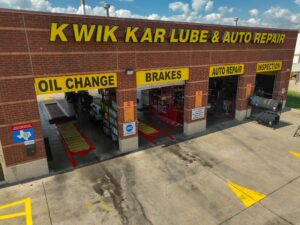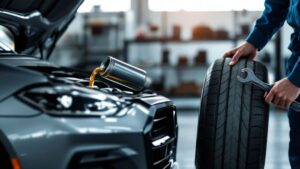Keeping Your Car in Tip-Top Shape
This car maintenance checklist PDF provides a concise 7-point guide to keep your vehicle running smoothly and safely. Learn essential maintenance tasks, from simple DIY checks like fluid top-offs to more complex procedures like brake service. Proper maintenance extends your car's life, improves fuel efficiency, and prevents costly repairs. This checklist empowers you to proactively address key areas like oil changes, tire rotations, and battery testing. Download our free car maintenance checklist PDF and take control of your vehicle's health today.
1. Oil Change and Filter Replacement
Regular oil changes and filter replacements are arguably the most crucial tasks on any car maintenance checklist pdf. Engine oil is the lifeblood of your vehicle, lubricating moving parts, reducing friction and heat, and flushing away harmful contaminants. Over time, oil degrades and becomes less effective, increasing the risk of engine wear and damage. Adhering to the manufacturer's recommended oil change intervals, typically every 3,000 to 10,000 miles depending on the vehicle and oil type, is paramount for ensuring your engine's longevity and optimal performance.
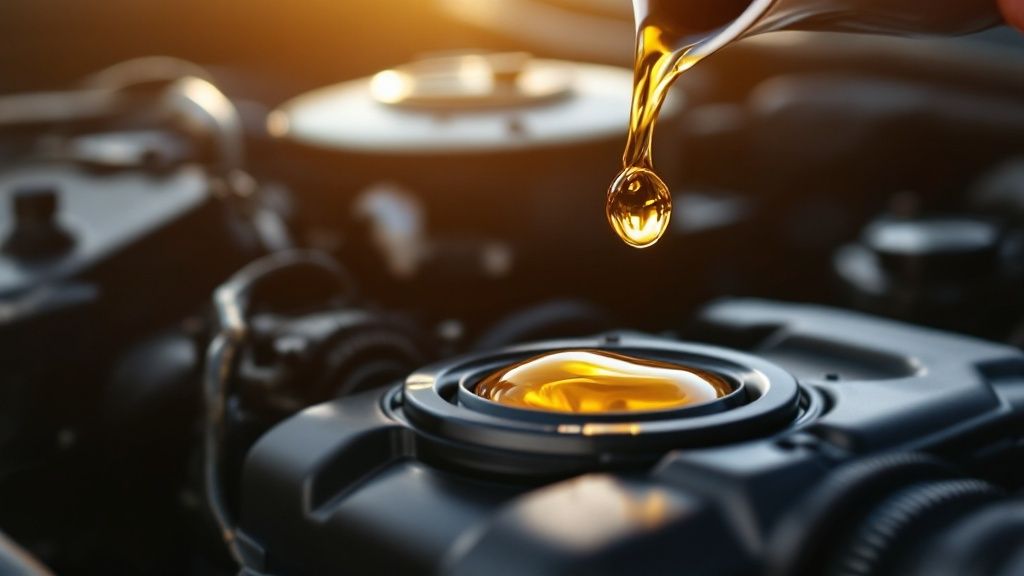
This seemingly simple maintenance task offers several significant benefits: it prevents premature engine wear and tear, maintains proper lubrication, removes contaminants and debris, improves fuel efficiency, and ultimately extends the life of your engine. These benefits translate into long-term cost savings by avoiding expensive engine repairs down the line.
When considering your oil change, understanding the difference between synthetic and regular oil is crucial. Check out this article for a detailed comparison: synthetic vs. regular oil change Synthetic Oil Change vs Regular: Which is Better in 2025? from Express Lube and Car Care.
For those on a budget or with basic mechanical skills, an oil change can be a relatively inexpensive DIY project. However, remember that proper disposal of used oil is essential. The frequency requirements vary depending on the vehicle and driving conditions, highlighting the importance of consulting your owner's manual for specific recommendations. Furthermore, the quality of both the oil and the filter significantly impacts the effectiveness of the oil change, so choosing reputable brands is advisable.
For example, Toyota recommends synthetic oil changes every 10,000 miles on newer models, whereas heavy-duty trucks, especially those used for towing, often require more frequent changes. This exemplifies the importance of adhering to manufacturer specifications.
Here are some actionable tips for incorporating oil changes into your car maintenance checklist pdf:
- Check your owner's manual: Consult your manual for the recommended oil type, viscosity, and change intervals specific to your vehicle.
- Document each oil change: Keep a logbook or record on your car maintenance checklist pdf noting the date and mileage of each oil change.
- Consider synthetic oil: Synthetic oils offer extended change intervals and superior performance, especially in demanding conditions.
- Always replace the oil filter: The oil filter traps contaminants, and replacing it with every oil change ensures optimal filtration.
- Check for leaks: A few days after an oil change, inspect the area around the oil filter and drain plug for any signs of leaks.
Including oil changes in your car maintenance checklist pdf is a proactive and cost-effective way to protect your investment and ensure your vehicle runs smoothly for years to come. Popular brands like Jiffy Lube, Valvoline, Mobil 1, and Pennzoil further underscore the importance of this fundamental maintenance procedure.
2. Tire Maintenance and Rotation
Tire maintenance and rotation is a crucial aspect of vehicle upkeep, significantly impacting safety, performance, and fuel economy. This involves regularly inspecting your tires for wear and tear, maintaining correct tire pressure, rotating them to ensure even wear, and performing wheel alignments as needed. Your tires are the only contact point between your car and the road, so their condition directly affects your vehicle's overall performance and, most importantly, your safety. This makes tire maintenance a vital inclusion in any car maintenance checklist pdf.

Proper tire maintenance, including regular rotations, offers several key benefits. It extends the lifespan of your tires by promoting even wear across the tread. Correct tire pressure maximizes fuel efficiency and improves handling and braking performance. Furthermore, it reduces the risk of blowouts, flat tires, and provides enhanced traction in various weather conditions, crucial for Fort Worth drivers who experience diverse weather patterns. These benefits are essential for budget-conscious drivers, owners of high-mileage vehicles, and those prioritizing safety and performance.
Features and Benefits:
- Extends tire life: Rotating tires distributes wear evenly, preventing premature wear on any single tire.
- Improves fuel economy: Properly inflated tires minimize rolling resistance, leading to better fuel mileage.
- Enhances handling and braking: Correct tire pressure and even wear improve vehicle control and responsiveness.
- Reduces risk of blowouts and flat tires: Regular inspections can identify potential issues before they become dangerous.
- Provides better traction: Properly maintained tires offer better grip on the road, especially important in wet or icy conditions.
Pros:
- Significant safety benefits: Reduced risk of accidents due to improved handling and braking.
- Can double the useful life of tires: Proper maintenance, including rotation, dramatically extends tire life.
- Improves fuel efficiency by up to 3%: Correctly inflated tires can save money at the pump.
- Relatively simple maintenance that can prevent expensive repairs: Regular checks can prevent costly tire replacements and other repairs.
Cons:
- Requires regular monitoring of tire pressure: Maintaining correct pressure requires periodic checks.
- Rotation patterns vary by vehicle and tire type: Consult your owner's manual for the correct rotation pattern.
- Alignment services require professional equipment: While you can inspect for alignment issues, professional service is required for correction.
Examples:
- Michelin recommends checking tire pressure monthly to ensure optimal performance and safety.
- Ford F-150 owner's manuals specify a cross-rotation pattern for their trucks. This information is also vital for fleet managers and small business owners in Fort Worth operating similar vehicles.
Tips for Fort Worth Drivers:
- Check tire pressure when tires are "cold," meaning the car hasn't been driven for at least three hours.
- Inspect tires for abnormal wear patterns, such as uneven wear on one side, which may indicate alignment issues. Fort Worth roads can be tough on tires, so regular inspections are key.
- Use the penny test to check tread depth: Insert a penny with Lincoln's head down into the tread groove. If you can see all of Lincoln's head, the tread is too worn and needs replacement.
- Follow manufacturer-recommended rotation patterns and intervals outlined in your car's manual.
- Consider seasonal tire changes in areas with extreme weather. While Fort Worth doesn't experience harsh winters, specialized tires can improve performance in extreme heat.
Popularized By: Leading tire manufacturers like Michelin, Goodyear, Bridgestone, and retailers like Tire Rack emphasize the importance of tire maintenance.
By incorporating these tire maintenance and rotation practices into your car maintenance checklist pdf, you can ensure the safety, performance, and longevity of your vehicle, ultimately saving money and enhancing your driving experience in Fort Worth.
3. Brake System Inspection and Service
Your vehicle's braking system is arguably its most crucial safety feature. Regular inspection and service ensures reliable stopping power and can prevent accidents. This involves checking the entire system, from the pedal to the pads and everything in between. This process includes inspecting brake pads/shoes for wear, rotors/drums for scoring or warping, testing brake fluid condition, and verifying proper operation of all components, including hydraulic lines and the ABS system. A well-maintained brake system not only provides reliable stopping power but also prevents more expensive repairs down the line caused by neglected wear and tear. Including brake system maintenance in your car maintenance checklist PDF is essential for safe and reliable vehicle operation.
This service is crucial for any car owner, especially those in Fort Worth who navigate busy roads and highways. For budget-conscious drivers, regular brake inspections can prevent costly repairs stemming from severely worn components. Owners of high-mileage or aging vehicles in particular should pay close attention to their brake systems, as wear and tear accelerates over time. Fleet managers and small business owners can ensure the safety and reliability of their vehicles, minimizing downtime and maximizing productivity, through routine brake system service. For drivers focused on safety and performance, a well-maintained brake system offers peace of mind and optimal stopping power.
Features of a Thorough Brake System Inspection:
- Ensures reliable vehicle stopping power: This is the primary benefit, allowing you to stop safely and confidently.
- Prevents brake system failure: Regular maintenance catches potential problems early, preventing complete system failures.
- Reduces noise and vibration while braking: Worn components can cause squealing, grinding, or pulsating during braking. Service addresses these issues.
- Identifies wear patterns that may indicate other issues: Uneven wear can point to problems with calipers, rotors, or other components.
- Includes inspection of hydraulic components and lines: This ensures that the entire system is functioning correctly, from the master cylinder to the brake calipers.
Pros:
- Direct impact on vehicle safety: This is the most important advantage.
- Early detection prevents costly repairs: Addressing minor issues early prevents them from becoming major, expensive problems.
- Extends the life of brake system components: Proper maintenance keeps components functioning optimally for longer.
- Provides peace of mind for critical safety system: Knowing your brakes are in good condition provides confidence and reduces stress.
Cons:
- Complete service often requires professional tools: While some checks can be done at home, a thorough inspection often requires specialized equipment.
- Brake fluid is hygroscopic and can be contaminated even if not used frequently: Brake fluid absorbs moisture over time, which can reduce its effectiveness.
- Quality of replacement parts significantly affects performance: Using high-quality parts is essential for optimal braking performance and longevity.
Examples:
- Honda recommends brake fluid replacement every 3 years regardless of mileage, highlighting the importance of this often-overlooked maintenance item.
- Many BMW vehicles include brake pad wear sensors that illuminate a dashboard warning light, providing a convenient reminder for service.
Actionable Tips:
- Listen for squealing, grinding, or pulsating while braking: These are all signs of potential brake problems.
- Inspect brake fluid color: It should be clear to light amber. Dark brown fluid indicates contamination and requires replacement.
- Replace brake pads when they reach 3-4mm thickness: Don't wait until they're completely worn down.
- Always replace pads as complete axle sets (both front or both rear): This ensures even braking performance.
- Check for even pad wear: Uneven wear may indicate caliper issues.
Popularized By: Leading brake manufacturers like Brembo, Akebono, Wagner, and EBC Brakes underscore the importance of regular brake system maintenance. Their expertise and high-quality products contribute to safer and more reliable braking systems.
4. Air and Cabin Filter Replacement
Your car relies on two crucial filter systems: the engine air filter and the cabin air filter. These filters play distinct roles in maintaining both your vehicle's performance and your comfort. The engine air filter safeguards your engine by preventing debris like dust, leaves, and insects from entering and causing damage. The cabin air filter, on the other hand, cleans the air circulating inside your vehicle, removing pollen, dust, and other pollutants before you breathe them in. Over time, both filters become clogged, restricting airflow and reducing their effectiveness. This can lead to decreased engine performance, reduced fuel efficiency, and poorer air quality inside your cabin. Regular replacement, as part of a comprehensive car maintenance checklist pdf, is essential.
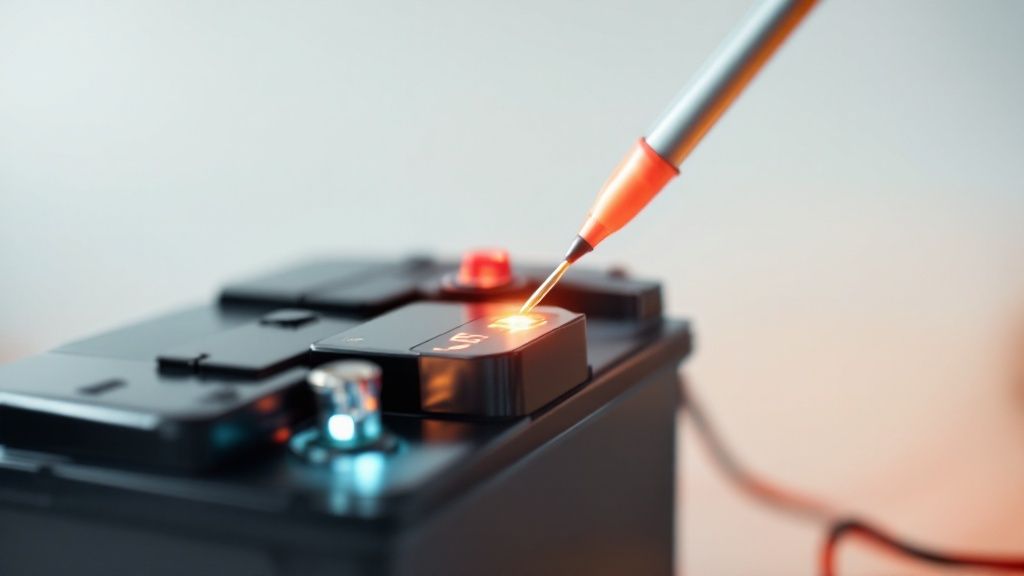
This seemingly small maintenance item offers significant benefits for drivers in Fort Worth and beyond. A clean engine air filter ensures proper airflow to the engine, contributing to optimal fuel efficiency – a crucial factor for budget-conscious drivers. The cabin air filter is your defense against Fort Worth's pollen and dust, enhancing cabin comfort, especially for those with allergies. For owners of high-mileage or aging vehicles, maintaining these filters helps preserve engine health and ensures a comfortable driving experience. Fleet managers and small business owners in Fort Worth can benefit from the improved fuel economy and reduced maintenance costs that come with regular filter replacements. Safety-conscious drivers will also appreciate the improved engine performance and clear visibility provided by clean filters.
Features and Benefits:
- Engine Air Filter: Protects the engine from harmful contaminants, maximizing engine life and performance.
- Cabin Air Filter: Improves the air quality within the vehicle, reducing allergens and odors for a more comfortable ride.
- Improved Fuel Efficiency: A clean engine air filter allows for optimal air-fuel mixture, leading to better gas mileage.
- Enhanced HVAC System Performance: Clean filters ensure proper airflow through the HVAC system, maximizing heating and cooling efficiency.
Pros:
- Cost-Effective: Air and cabin filters are relatively inexpensive to replace.
- DIY Friendly: In most vehicles, these filters can be easily replaced at home, saving on labor costs. For example, the Toyota Camry cabin filter is easily accessible behind the glove box, and many Ford F-150 engine air filters can be changed without tools.
- Improved Comfort: A clean cabin filter drastically reduces allergens and odors, creating a more pleasant environment inside the vehicle.
Cons:
- Frequency Varies: Driving conditions in dusty Fort Worth may necessitate more frequent filter changes.
- OEM vs. Aftermarket: Original Equipment Manufacturer (OEM) filters often cost more than aftermarket options.
- Accessibility: Cabin filter access can be challenging in some vehicle models.
Actionable Tips:
- Visual Inspection: Hold your engine air filter up to a light. If light can’t pass through, it's time for a replacement.
- Upgrade Options: Consider a high-performance air filter, like those from K&N, for increased airflow.
- Allergy Considerations: Replace your cabin filter more often if you suffer from allergies or frequently drive in heavily polluted areas.
- Owner's Manual: Consult your owner's manual for specific filter locations and replacement instructions.
- Odor Control: Activated carbon cabin filters, offered by brands like FRAM, Bosch, and Wix, are excellent for odor reduction.
Including air and cabin filter replacement in your car maintenance checklist pdf is a simple yet highly effective way to ensure optimal engine performance, improve fuel efficiency, and enhance your overall driving experience in Fort Worth. This cost-effective maintenance task can save you money on fuel and repairs in the long run, making it a valuable addition to any car owner's routine.
5. Fluid Checks and Replacements
Fluid checks and replacements are a crucial part of any car maintenance checklist, directly impacting your vehicle's reliability, performance, and longevity. This essential maintenance task deserves a prominent spot on your car maintenance checklist pdf because it addresses the lifeblood of various vehicle systems. Ignoring fluid maintenance can lead to costly repairs down the road, making it a vital aspect of preventative care.
Your vehicle relies on several fluids for proper operation. These fluids, including transmission fluid, coolant/antifreeze, power steering fluid, and brake fluid, each perform specific functions and are subject to degradation over time due to heat, contaminants, and chemical breakdown. Regular inspection and replacement according to the manufacturer's recommendations (outlined in your owner's manual) is key to preventing system damage, extending component life, and maintaining optimal performance.
How it Works:
Each fluid plays a critical role:
- Transmission Fluid: Lubricates and cools the transmission, enabling smooth gear changes.
- Coolant/Antifreeze: Regulates engine temperature, preventing overheating and protecting against freezing in cold weather.
- Power Steering Fluid: Transmits hydraulic pressure to assist in steering.
- Brake Fluid: Transfers force from the brake pedal to the brake calipers, enabling safe stopping.
Regular checks involve inspecting the fluid levels, condition (color and clarity), and looking for any signs of leaks. Replacements involve draining the old fluid and replenishing with the correct type and amount of new fluid.
Features and Benefits:
- Covers Multiple Critical Systems: This maintenance item addresses vital systems like the transmission, engine cooling system, power steering, and braking system.
- Prevents Overheating and System Failures: Maintaining proper fluid levels and condition prevents critical failures and costly repairs.
- Maintains Proper Lubrication and Hydraulic Pressure: Ensures smooth operation and prevents premature wear of components.
- Includes Checking for Leaks and Contamination: Proactive identification of leaks prevents roadside breakdowns and further damage.
- Each Fluid Has Specific Maintenance Intervals: Following the manufacturer's schedule ensures optimal protection and performance.
Pros:
- Preventive Maintenance that Avoids Expensive Repairs: Addressing fluid maintenance proactively saves money in the long run.
- Many Fluid Levels Can Be Checked by Vehicle Owners: Empowers car owners to take an active role in vehicle maintenance.
- Early Detection of Leaks Prevents Roadside Breakdowns: Increases safety and minimizes inconvenience.
- Extends the Life of Expensive Components Like Transmissions: Protecting vital components maximizes vehicle lifespan.
Cons:
- Some Fluids Require Special Tools to Check and Replace: Certain fluid checks and changes may require specialized equipment.
- Modern Vehicles Often Have Sealed Systems Requiring Dealer Service: Some newer vehicles require dealer-specific tools and expertise.
- Using Incorrect Fluid Type Can Cause Serious Damage: Always consult your owner's manual for the correct fluid specifications.
- Complete Fluid Exchanges Often Require Professional Equipment: Flushing and completely replacing fluids often requires professional equipment.
Examples:
- Mercedes-Benz specifies a 40,000-mile interval for automatic transmission fluid changes.
- Subaru coolant typically requires replacement every 100,000 miles or 10 years. These examples highlight the importance of adhering to manufacturer-specific schedules.
Actionable Tips for Fort Worth Drivers:
- Check fluid levels when the engine is cold (except transmission fluid, which is checked when warm).
- Look for fluid color changes that indicate contamination. Dark or discolored fluids may need to be replaced.
- Use only manufacturer-recommended fluid types and specifications. This information can be found in your owner's manual.
- Consider more frequent changes for severe driving conditions. Stop-and-go traffic, extreme temperatures, and towing require more frequent maintenance.
- Don't mix different brands or types of coolant. Mixing coolants can lead to reduced effectiveness and potential damage.
Popularized By: Leading brands like Valvoline, Castrol, Prestone, and Motul emphasize the importance of regular fluid maintenance. This widespread recognition further reinforces the value of this essential maintenance item.
By incorporating fluid checks and replacements into your car maintenance checklist pdf, you take a proactive step towards ensuring the health and longevity of your vehicle. This preventative measure can save you significant money on repairs down the road and contribute to a safer and more reliable driving experience in Fort Worth.
6. Battery Maintenance and Testing
A reliable battery is crucial for any vehicle, especially in a bustling city like Fort Worth. This section of your car maintenance checklist pdf addresses battery maintenance and testing, ensuring your vehicle starts reliably every time and avoids leaving you stranded. Ignoring your battery can lead to unexpected breakdowns, expensive repairs, and potential damage to sensitive electronic systems, a situation no Fort Worth driver wants to experience. This is why battery care deserves a prominent spot on your car maintenance checklist.
Your vehicle's battery is the heart of its electrical system, providing the initial power to start the engine and a stable power supply for accessories like lights, radio, and increasingly complex computer systems. Modern vehicles, with their extensive electronic components, are particularly vulnerable to battery issues. Battery maintenance involves a few key steps:
- Terminal Inspection and Cleaning: Corrosion on battery terminals can impede the flow of electricity, leading to starting problems. Regular inspection and cleaning are essential.
- Charge Level Check: Ensuring your battery maintains the proper charge level is vital for reliable starting and prevents premature battery failure.
- Capacity Testing: A battery capacity test helps determine the overall health of your battery and can predict potential failure before it happens, allowing you to replace it proactively.
- Charging System Inspection: This includes checking the alternator, which replenishes the battery's charge while the engine is running. A faulty alternator can lead to a discharged battery and other electrical problems.
Examples of Successful Implementation:
- Just as AAA responds to more dead battery calls than any other roadside assistance issue nationwide, similar services in Fort Worth see the same trend. Proper battery maintenance can drastically reduce your chances of needing a jump start.
- Modern vehicles, like Tesla's, utilize sophisticated battery management systems to maintain charge even when parked, highlighting the importance of a healthy battery in today's cars.
Actionable Tips for Fort Worth Drivers:
- Clean battery terminals: Use a baking soda solution and a wire brush to remove corrosion. Applying a terminal protectant spray after cleaning helps prevent future buildup.
- Battery maintainer: If you store your vehicle for extended periods, use a battery maintainer to prevent discharge. This is especially important for the hot Fort Worth summers and occasional cold snaps.
- Annual charging system test: Have your charging system tested annually, including the alternator, to ensure it's functioning correctly. A healthy charging system is essential for battery longevity.
- Proactive replacement: Consider replacing your battery preemptively every 4-5 years, especially in the extreme Texas climate. This can save you from unexpected breakdowns and potential damage to your vehicle's electrical system.
Pros:
- Reduces the risk of being stranded with a dead battery, a common and frustrating occurrence, especially in Fort Worth traffic.
- Regular cleaning prevents connection issues and ensures reliable starting.
- Battery testing can predict failure before it happens, allowing for proactive replacement.
- Proper maintenance can extend battery life by 1-2 years, saving you money in the long run.
Cons:
- Battery load testing requires specialized equipment, which may necessitate a visit to a qualified mechanic in Fort Worth.
- Modern batteries are often "maintenance-free" with limited serviceability.
- Extreme temperatures, a hallmark of the Fort Worth climate, significantly affect battery performance regardless of maintenance.
Popularized By: Interstate Batteries, DieHard, Optima, Exide
By including battery maintenance and testing in your car maintenance checklist pdf, you’ll be taking a proactive step towards ensuring reliable starts, preventing costly electrical system damage, and extending the life of your battery. This is a valuable investment for any Fort Worth driver, regardless of their budget or vehicle type. From budget-conscious drivers to fleet managers, everyone benefits from a reliable vehicle and a proactive approach to maintenance.
7. Belt and Hose Inspection
This crucial part of your car maintenance checklist pdf deserves a dedicated spot due to its potential to prevent catastrophic engine damage and costly repairs. Belt and hose inspection involves visually examining the engine belts (serpentine, timing) and hoses (radiator, heater, power steering) for signs of wear, tear, and impending failure. These rubber components are constantly exposed to heat, oil, and stress, causing them to deteriorate over time. Ignoring their condition can lead to unexpected breakdowns, overheating, and even complete engine failure.
How it Works:
Engine belts transfer power from the crankshaft to essential components like the alternator, power steering pump, and air conditioning compressor. The timing belt, specifically, synchronizes the rotation of the crankshaft and camshaft, ensuring proper engine timing. Hoses, on the other hand, circulate vital fluids like coolant and power steering fluid. A broken belt can disable multiple systems, while a burst hose can lead to overheating or loss of steering control. Regular inspection allows you to catch issues early before they escalate into major problems.
Why It's Important for Your Car Maintenance Checklist PDF:
Including belt and hose inspection in your car maintenance checklist pdf is crucial for several reasons:
- Prevents Unexpected Breakdowns: Identifying and replacing worn belts and hoses before they fail prevents inconvenient and potentially dangerous roadside emergencies.
- Identifies Wear Before Failure Occurs: Visual inspection can reveal cracks, fraying, glazing, bulges, leaks, and other signs of deterioration, allowing for proactive maintenance. Checking tension and alignment is also crucial for optimal belt performance.
- Prevents Engine Overheating: Maintaining healthy hoses prevents coolant leaks, protecting your engine from overheating and potential damage.
- Critical for Maintaining Engine Timing and Accessory Function: The timing belt is especially vital in interference engines, where a broken belt can result in the pistons colliding with the valves, leading to extensive engine damage.
Examples:
- Honda recommends timing belt replacement at 105,000 miles on many models, illustrating the importance of scheduled maintenance.
- A broken timing belt in an interference engine can necessitate a complete engine rebuild, a costly repair easily avoided with preventive maintenance.
Pros:
- Relatively Inexpensive Maintenance: Compared to the cost of engine repairs or replacements, belts and hoses are relatively inexpensive to replace.
- Visual Inspection Can Identify Many Issues: A simple visual inspection can often reveal problems without needing specialized tools.
- Scheduled Replacement Prevents Roadside Emergencies: Adhering to the manufacturer's recommended replacement intervals significantly reduces the risk of unexpected breakdowns. This is particularly important for older vehicles and those operated in extreme climates (like those we experience in Fort Worth).
Cons:
- Timing Belt Replacement Is Labor-Intensive and Expensive: While the timing belt itself isn't excessively expensive, the labor involved in replacing it can be substantial.
- Some Components Are Difficult to Access for Visual Inspection: Certain belts and hoses may be obscured by other engine components, making a thorough inspection challenging.
- Determining the Exact Condition Can Sometimes Be Subjective: Assessing the remaining lifespan of a belt or hose can be subjective, requiring experience and judgment.
Actionable Tips:
- Look for cracks, fraying, glazing, and oil contamination on belts.
- Check hoses by squeezing them to feel for brittleness or excessive softness. Look for leaks, bulges, or cracks.
- Replace timing belts according to the manufacturer's schedule even if they look good.
- Consider replacing all drive belts when replacing one.
- Mark the inspection date and mileage on replacement parts with a permanent marker.
Popularized By: Trusted brands like Gates, Dayco, Continental, and Goodyear are known for producing high-quality belts and hoses.
By incorporating belt and hose inspection into your car maintenance checklist pdf, you can proactively address potential problems, save money on costly repairs, and ensure the smooth and reliable operation of your vehicle. This is especially valuable for budget-conscious drivers in Fort Worth looking to maximize the lifespan of their vehicles.
7-Point Car Maintenance Checklist Comparison
| Maintenance Task | Implementation Complexity 🔄 | Resource Requirements ⚡ | Expected Outcomes 📊 | Ideal Use Cases 💡 | Key Advantages ⭐ |
|---|---|---|---|---|---|
| Oil Change and Filter Replacement | Moderate | Basic tools, quality oil & filter | Extends engine life, reduces wear, improves fuel efficiency | Routine engine upkeep, long-term engine health | Cost-effective, DIY-friendly, immediate impact |
| Tire Maintenance and Rotation | Low | Tire pressure gauge, rotation knowledge | Enhanced safety, extended tire life, improved handling | Regular vehicle safety checks, fuel economy | Safety boost, tire longevity, fuel savings |
| Brake System Inspection and Service | Moderate to High | Professional tools recommended | Reliable stopping power, prevents failures | Critical safety maintenance | Safety assurance, early problem detection |
| Air and Cabin Filter Replacement | Low | Replacement filters | Improved air quality and engine performance | Allergy sufferers, dusty environments | Low cost, easy DIY, comfort enhancement |
| Fluid Checks and Replacements | Moderate | Various fluids, possible special tools | Prevents overheating, maintains lubrication | Comprehensive vehicle system maintenance | Preventive care, avoids major repairs |
| Battery Maintenance and Testing | Low to Moderate | Cleaning supplies, test equipment | Reliable starts, extended battery life | Vehicles in extreme climates, older batteries | Reduces dead battery risk, predictive testing |
| Belt and Hose Inspection | Moderate | Inspection tools, replacement parts | Prevents breakdowns, maintains engine timing | Older vehicles, extreme environments | Inexpensive preventive measure, avoids failures |
Ready to Take Action?
Staying on top of car maintenance can feel overwhelming, but with a simple car maintenance checklist PDF, you can easily track essential tasks and keep your vehicle in peak condition. From oil changes and filter replacements to brake inspections and fluid checks, this article has outlined the key maintenance procedures that contribute to a safe, reliable, and long-lasting vehicle. Remember, consistent preventative maintenance not only saves you money on costly repairs down the road but also ensures your safety and maximizes your car's performance. Whether you're a budget-conscious driver in Fort Worth, managing a fleet of vehicles, or simply want the peace of mind that comes with a well-maintained car, a car maintenance checklist PDF is an invaluable tool.
Download your free car maintenance checklist PDF today and take control of your car's health. At Kwik Kar on White Settlement Rd. in Fort Worth, Texas, we understand the importance of regular maintenance and offer top-quality service using genuine parts. From high-mileage vehicles to routine tune-ups, we're equipped to handle all your car care needs. Your car is an investment, and proactive maintenance is the best way to protect it. Print out the checklist and bring it with you on your next visit to Kwik Kar, or simply stop by for expert advice and service. For questions, call us at [Phone Number].
Ready to experience the Kwik Kar difference and keep your car running smoothly? Visit Kwik Kar Oil Change and Auto Care to schedule your next service appointment and download our comprehensive car maintenance checklist PDF. We're here to partner with you in maintaining your vehicle's optimal performance and safety.

